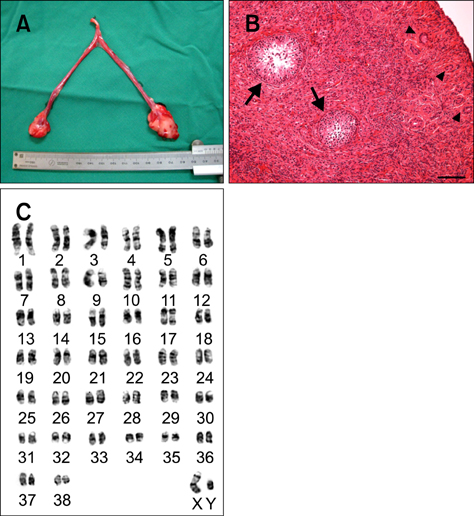J Vet Sci.
2012 Jun;13(2):211-213. 10.4142/jvs.2012.13.2.211.
SRY-positive 78, XY ovotesticular disorder of sex development in a wolf cloned by nuclear transfer
- Affiliations
-
- 1Department of Theriogenology and Biotechnology, College of Veterinary Medicine, Seoul National University, Seoul 151-742, Korea. bclee@snu.ac.kr
- 2Department of Pathology, College of Veterinary Medicine, Seoul National University, Seoul 151-742, Korea.
- 3College of Agriculture and Life Sciences, Chungnam National University, Daejeon 305-764, Korea.
- KMID: 1376198
- DOI: http://doi.org/10.4142/jvs.2012.13.2.211
Abstract
- Recently, we reported the three wolves cloning with normal karyotype from somatic cells of endangered male gray wolves (Canis lupus), but one wolf had female external genitalia. In this study, we conducted further clinical, histological, and genetic analyses. This cloned wolf had a normal uterus but developed ovotestis. Through molecular analysis of the SRY gene, a mutation in the coding sequence of SRY gene could be excluded as a cause of intersexuality. This is the first report of a cloned wolf with a 78, XY ovotesticular disorder affecting sexual development characterized by bilateral ovotestes.
Keyword
MeSH Terms
Figure
Reference
-
1. Beijerink NJ, Buijtels JJCWM, Okkens AC, Kooistra HS, Dieleman SJ. Basal and GnRH-induced secretion of FSH and LH in anestrous versus ovariectomized bitches. Theriogenology. 2007. 67:1039–1045.
Article2. De Lorenzi L, Groppetti D, Arrighi S, Pujar S, Nicoloso L, Molteni L, Pecile A, Cremonesi F, Parma P, Meyers-Wallen V. Mutations in the RSPO1 coding region are not the main cause of canine SRY-negative XX sex reversal in several breeds. Sex Dev. 2008. 2:84–95.
Article3. Gubbay J, Collignon J, Koopman P, Capel B, Economou A, Münsterberg A, Vivian N, Goodfellow P, Lovell-Badge R. A gene mapping to the sex-determining region of the mouse Y chromosome is a member of a novel family of embryonically expressed genes. Nature. 1990. 346:245–250.
Article4. Jurka P, Galanty M, Zielinska P, Max A, Sysa P. Hypospadias in six dogs. Vet Rec. 2009. 164:331–333.
Article5. Lee BC, Kim MK, Jang G, Oh HJ, Yuda F, Kim HJ, Hossein MS, Kim JJ, Kang SK, Schatten G, Hwang WS. Dogs cloned from adult somatic cells. Nature. 2005. 436:641.
Article6. Meyers-Wallen VN. Genetics, genomics, and molecular biology of sex determination in small animals. Theriogenology. 2006. 66:1655–1658.
Article7. Oh HJ, Kim MK, Jang G, Kim HJ, Hong SG, Park JE, Park K, Park C, Sohn SH, Kim DY, Shin NS, Lee BC. Cloning endangered gray wolves (Canis lupus) from somatic cells collected postmortem. Theriogenology. 2008. 70:638–647.
Article8. Pajares G, Balseiro A, Pérez-Pardal L, Gamarra JA, Monteagudo LV, Goyache F, Royo LJ. Sry-negative XX true hermaphroditism in a roe deer. Anim Reprod Sci. 2009. 112:190–197.
Article9. Poth T, Breuer W, Walter B, Hecht W, Hermanns W. Disorders of sex development in the dog-Adoption of a new nomenclature and reclassification of reported cases. Anim Reprod Sci. 2010. 121:197–207.
Article10. Weng Q, Murase T, Asano M, Tsubota T. Male Pseudohermaphroditism in a raccoon dog (Nyctereutes procynoides). J Vet Med Sci. 2005. 67:603–605.
- Full Text Links
- Actions
-
Cited
- CITED
-
- Close
- Share
- Similar articles
-
- The rare case of 46,XX testicular disorder of sex development carrying a heterozygous p.Arg92Trp variant in NR5A1
- Mixed gonadal dysgenesis in 45,X Turner syndrome with SRY gene
- A Case of 46,XY Pure Gonadal Dysgenesis with Loss of the Sex-Determining Region of Y Chromosome
- Differential Diagnosis of Disorders of Sex Development (DSD) by Molecular Genetic Analyses
- SRY Gene Evaluation in Patients with the Disorders of Sexual Differentiation


